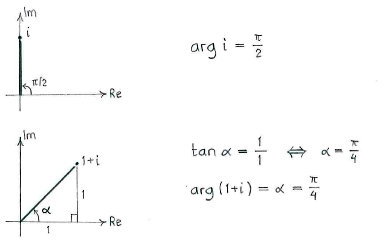Lösung 3.2:5d
Aus Online Mathematik Brückenkurs 2
(Unterschied zwischen Versionen)
K |
K (Robot: Automated text replacement (-{{Displayed math +{{Abgesetzte Formel)) |
||
| Zeile 3: | Zeile 3: | ||
The argument of the quotient <math>i/(1+i)</math> is therefore | The argument of the quotient <math>i/(1+i)</math> is therefore | ||
| - | {{ | + | {{Abgesetzte Formel||<math>\arg\frac{i}{1+i} = \arg i - \arg (1+i)\,\textrm{.}</math>}} |
We obtain the argument of <math>i</math> and <math>1+i</math> by drawing the numbers in the complex plane and using a little trigonometry. | We obtain the argument of <math>i</math> and <math>1+i</math> by drawing the numbers in the complex plane and using a little trigonometry. | ||
| Zeile 11: | Zeile 11: | ||
Hence, we obtain | Hence, we obtain | ||
| - | {{ | + | {{Abgesetzte Formel||<math>\arg\frac{i}{1+i} = \arg i - \arg (1+i) = \frac{\pi}{2} - \frac{\pi}{4} = \frac{\pi}{4}\,\textrm{.}</math>}} |
Version vom 13:09, 10. Mär. 2009
When dividing two complex numbers, the numerator's magnitude is divided by the denominator's magnitude and the numerator's argument is subtracted from the numerator's argument.
The argument of the quotient \displaystyle i/(1+i) is therefore
| \displaystyle \arg\frac{i}{1+i} = \arg i - \arg (1+i)\,\textrm{.} |
We obtain the argument of \displaystyle i and \displaystyle 1+i by drawing the numbers in the complex plane and using a little trigonometry.
Hence, we obtain
| \displaystyle \arg\frac{i}{1+i} = \arg i - \arg (1+i) = \frac{\pi}{2} - \frac{\pi}{4} = \frac{\pi}{4}\,\textrm{.} |

